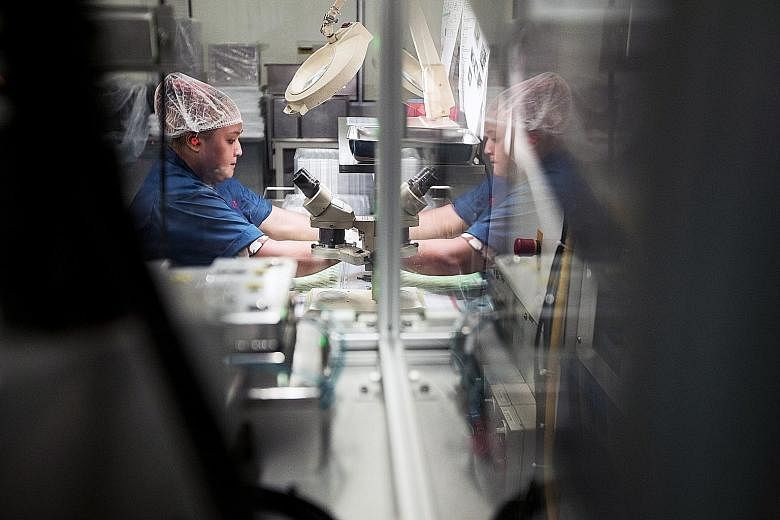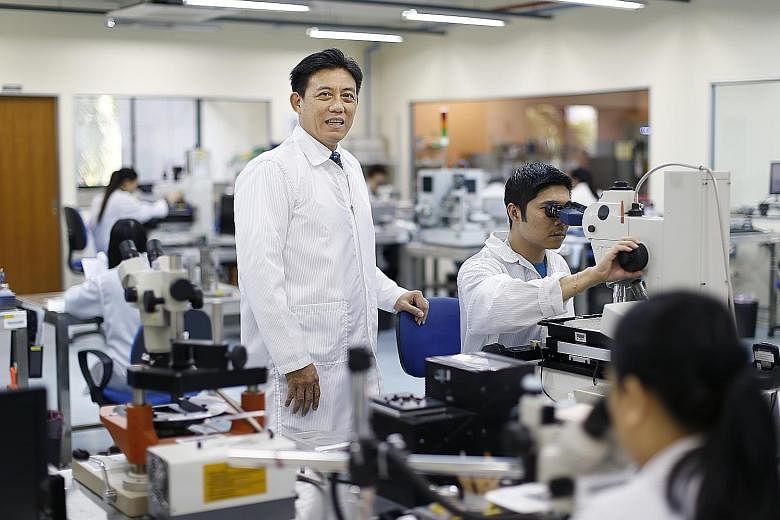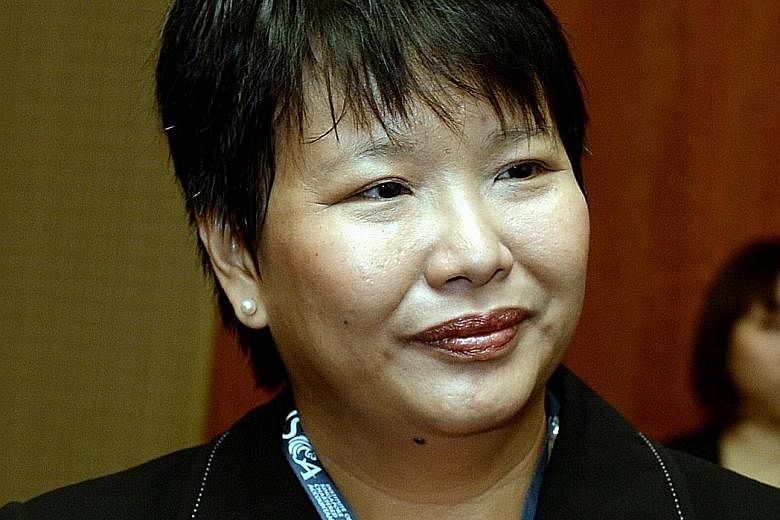It has been a year of high drama to say the least for the Singapore economy - going from the cusp of recession to its fastest pace of growth in almost a half-decade.
This remarkable turnaround was thanks largely to surging global demand for electronic gadgets, a factor expected to continue driving growth this year.
The pick-up in activity is fuelling optimism among economists, corporates and other market watchers about the year ahead, yet there are lingering concerns over Singapore's longer-term growth prospects.
Certainly over the past year or so, manufacturing has been the star and it could deliver again in 2018.
A slew of new consumer electronics releases - including mobile phone models - fuelled a pick-up in global demand for semiconductors and related equipment and helped reverse the economy's fortune.
This trend started in the final months of 2016, thanks in large part to the year-end surge in manufacturing output.
Manufacturing, which makes up a fifth of the economy, continued to buoy overall growth during the year.
There are concerns that the trade-driven lift from electronics might fizzle out. But the pick-up is showing signs of broadening to benefit other industries - in particular, the services sector, which makes up two-thirds of the economy and employs the bulk of workers.
"What we've been seeing is a two-speed economy in Singapore where the pick-up wasn't necessarily passing through to the domestic economy," says HSBC chief Asean economist Joseph Incalcaterra.
"Finally we're starting to see signs that this is ending and growth is becoming more broad-based."
The pace of economic activity could slow slightly this year - partly due to 2017's high base. But 2018 will also be the services sector's turn to shine - especially since manufacturers could find it tough to keep up 2017's breakneck pace.
ING economist Rob Carnell says Singapore's economy "has already turned the corner" and is "moving up a gear in terms of activity".
CIMB Private Bank economist Song Seng Wun says 2017's rapid expansion in factory output "is probably not sustainable", but the sector is still expected to register robust growth of between 4 and 7 per cent in 2018.
"We may see some moderation from electronics but the drag from oil and gas is also subsiding. We are even seeing some signs of marine and offshore selectively hiring. Chemicals and other industries will also help support growth in the sector," he notes.
Services sector growth has been lagging behind manufacturing but the gap should narrow in the coming quarters, Mr Song says, noting: "Services should add more to growth in 2018 than it has in the previous few years."
He expects the economy to grow by 3.7 to 3.8 per cent in 2018: "The pace is similar to 2017 but the contribution to growth will be more balanced - more of it will come from service-producing industries."
DBS senior economist Irvin Seah agrees that services could replace manufacturing as the key driver of the economy this year.
Government forecasters are tipping growth of 1.5 per cent to 3.5 per cent for 2018.
Credit Suisse economist Michael Wan says the slight slowdown will be driven in part by a dip in China's growth, which could dampen Singapore's exports.
"Nonetheless, the expected strength in the US and European Union economies in 2018 should offset these drags to some extent," he notes. Mr Wan expects the economy to grow by 3 per cent in 2018, from 3.4 per cent this year.
Still, some manufacturers remain cheerful about prospects.
Mr Sam Chee Wah, general manager of precision engineering firm Feinmetall Singapore, expects sales to have gone up 4 to 6 per cent in 2017 and the firm already has a strong orderbook for the first three months of 2018.
In 2017, he says, "the industry as a whole did well - better than the year before. Activities are picking up strongly in sectors like precision engineering, biomed, mobile and automotive.
"This is partly due to new product launches but also emerging trends like digitisation and the Internet of Things. Many companies are moving towards these technologies and this generates demand for sensors and data tracking equipment.
"We are quite optimistic for the first half" of 2018, adds Mr Sam.
With the pace of economic expansion picking up both here and around the world, some economists think tighter monetary policy could be on the agenda this year.
The Monetary Authority of Singapore (MAS) uses the exchange rate to strike a balance between inflation from overseas and economic growth. The rate is allowed to float within a band that can be adjusted when monetary policy is reviewed.
A stronger currency - which corresponds to tighter monetary policy - counters inflation by making imports cheaper in Singdollar terms, while a weaker Singdollar helps lift growth by making exports cheaper abroad.
The exchange rate is managed against a basket of currencies of Singapore's major trading partners.
The Singdollar policy band is now on a path of zero appreciation against the currencies of key trading partners - a "neutral" stance put in place in April 2016 amid slow growth and low inflation.
The MAS kept its policy unchanged at its review in October and has since reiterated that this stance remains appropriate.
But with growth picking up here and around the world, inflation looks set to follow suit especially if oil prices begin to recover as some market watchers expect.
A stronger currency would guard against this and help dampen inflation - which will also be under pressure from domestic factors, such as a prospective tax hike.
Many expect an eventual increase in the goods and services tax, which last went up in 2007 and is low relative to the rates of other nations in the region.
However, there is still a risk that the economy could take a turn for the worse. The ongoing manufacturing boom could turn out to be temporary and short-lived.
Some segments of the economy remain soft - the construction industry, for example, has been shrinking for at least five straight quarters.
The job market has also not quite turned the corner despite signs of recovery.
The long-term unemployment rate for Singaporeans and permanent residents rose to 0.8 per cent in September, up from 0.7 per cent in June. This rate measures the proportion of the resident labour force that has been unemployed for at least 25 weeks.
DBS' Mr Seah says the labour market still faces constraints: "Some jobs are disappearing as old industries fade. Automation and disruptive technologies could also reduce labour demand.
"And the new growth industries such as fintech, creative IT solutions, aerospace, robotics, and advanced manufacturing are less labour-intensive than older manufacturing industries.
"Nevertheless, an improvement in growth momentum, particularly in the services cluster, should help to lift the labour market over time."
Economists say the hard work of restructuring and innovation must continue even amid this upturn.
"While the growth outlook is looking more sanguine, on the ground there is still a fair bit of weakness, especially among small and medium-sized companies," says OCBC economist Selena Ling.
"A lot of productivity growth has been manufacturing - and electronics - driven; topline output has risen and bottom lines have come down in line with cost cutting in recent years.
"In the services sector, however, there is still a lot of room for improvement."
Ultimately, being ahead of the curve in this era of disruptive change "will be what guarantees medium-term growth for Singapore and will underpin our next leg of growth, beyond this whole cyclical expansion story", adds Ms Ling.
"If we settle for 1 to 3 per cent growth over the next five years, that will be undershooting our potential; I don't think that's the best that we can do."





